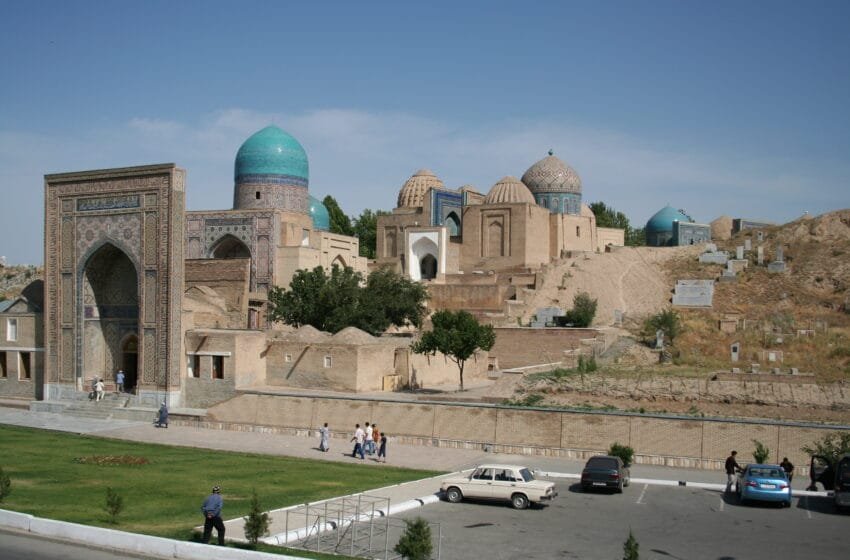Shah-i-Zinda: A 14th-15th Century Living Monument with Over 20 Mausoleums of Medieval Architecture

The Shah-i-Zinda Mausoleums.
Shah-i-Zinda (Uzbek: Shohizinda, Persian: شاه زنده, meaning “Living King”) is a stunning medieval architectural complex in Samarkand, Uzbekistan. This remarkable site consists of a series of mausoleums belonging to the Karakhanid and Timurid nobility. The complex, as it stands today, is comprised of eleven interconnected mausoleums constructed during the 14th and 15th centuries. However, archaeological excavations on the eastern slope of the Afrasiab settlement have uncovered remnants of mausoleums dating back to the 11th and 12th centuries.
In 2001, Shah-i-Zinda, alongside other historic landmarks in Samarkand, was inscribed on the UNESCO World Heritage List, solidifying its status as a priceless cultural treasure.
The Rich History of Shah-i-Zinda: A Monumental Journey Through Time
Shah-i-Zinda, meaning “The Living King,” is one of the most significant architectural and cultural landmarks in Samarkand, Uzbekistan. This complex, founded by the Karakhanid dynasty, has evolved over nine centuries and now includes more than 20 structures from the 11th to 14th and 19th centuries. Initially known as “Mazar Shah” (Tomb of the King), it was later renamed Shah-i-Zinda in the 16th century, referring to Qusam ibn Abbas, a cousin of the Prophet Muhammad and one of the first preachers of Islam in Central Asia.
Historical Evolution
The earliest remnants of the Shah-i-Zinda complex date back to the Karakhanid period (11th–12th centuries), including foundational structures and tombstones. However, the majority of its present-day mausoleums were constructed during the Timurid era (14th–15th centuries), showcasing the architectural splendor of that period. Subsequent modifications during the 16th–19th centuries had little impact on the original composition and appearance of the complex. The mausoleums, adorned with turquoise and dark blue tiles featuring floral motifs, remain striking examples of Islamic art and craftsmanship.
Shah-i-Zinda is unique among Samarkand’s architectural landmarks, representing nearly 25 centuries of urban history, including layers of culture from Afrasiab. This makes it a rare archaeological and architectural site that connects various epochs of Central Asia’s development.
Modern History and Preservation
In 1945, the Soviet authorities returned the Shah-i-Zinda complex to the Muslim Spiritual Board of Central Asia and Kazakhstan, allowing it to resume its role as a religious and cultural center. However, no burials have been conducted within the complex since 1977. A significant restoration took place in 2004–2005 under the government of Uzbekistan. During this restoration, a barrier wall along the right side of the pathway was removed, revealing previously hidden medieval structures, including a mosque, an 11th-century madrasa, and traces of older mausoleums.
Architectural Layout and Significance
The Shah-i-Zinda complex is divided into three main sections: the lower, middle, and upper groups of buildings, connected by arched and domed passageways known as chartaks.
- Lower Group:
This section includes a two-domed mausoleum near the entrance terrace, believed to be one of the earliest constructions in the complex. - Middle Group:
The middle section is home to the mausoleums of Timurid-era nobles, including Emir Zade (1386), Tughlu Tekin, Shadi Mulk Aka (1371–1372), and Shirin Bika Aka (1385–1386). These mausoleums, adorned with vibrant facades and intricate decorations, stand as testaments to the architectural innovation of their time. Among the unique structures here is an octagonal mausoleum dating back to the early 15th century, featuring glazed brick mosaics and an originally domed design. - Upper Group:
This area serves as the centerpiece of the complex, housing the Mausoleum of Qusam ibn Abbas. The site includes the ancient mausoleum, a 16th-century mosque, and a carved wooden door dated 1404–1405, originally inlaid with ivory. The upper section also features three mausoleums arranged around a serene courtyard, including the 14th-century Mausoleum of Khoja Ahmad and other significant structures such as the 15th-century Tuman Aka Mausoleum.
Restoration and Modern Discoveries
During the comprehensive restoration in 2004–2005, archaeologists uncovered remnants of early medieval structures and previously unknown tombs. This work highlighted the layered history of Shah-i-Zinda and its evolving architectural styles. The restoration aimed to preserve the intricate tilework, decorative mosaics, and structural integrity of the complex while opening new pathways for historical exploration.
Shah-i-Zinda continues to stand as an unparalleled symbol of Samarkand’s rich history, blending spiritual significance with architectural grandeur. Each building within the complex tells a story of devotion, artistic brilliance, and cultural synthesis, ensuring its place as one of the most treasured heritage sites in Central Asia.
Architectural Features
The Shah-i-Zinda complex is a masterpiece of Islamic architecture, showcasing intricate tilework, vibrant colors, and breathtaking geometric patterns. The mausoleums are arranged in a linear sequence along a narrow passageway, creating a sense of continuity and unity despite the diversity in individual designs.
Key features include:
- Exquisite Tilework: The facades of the mausoleums are adorned with vibrant turquoise, blue, and green tiles arranged in floral, epigraphic, and geometric motifs. These tiles reflect the high level of craftsmanship of the Timurid era.
- Domes and Arches: Each mausoleum features domes of varying sizes and styles, highlighting the architectural evolution over centuries. The pointed arches and intricate muqarnas (stalactite designs) add to the grandeur of the structures.
- Epigraphy: Many of the mausoleums feature Quranic verses and intricate calligraphy, emphasizing the spiritual significance of the site.
Cultural and Spiritual Importance
Beyond its architectural splendor, Shah-i-Zinda holds profound spiritual significance. The site has served as a pilgrimage destination for centuries, attracting visitors seeking blessings and paying homage to the revered figures buried there. Its historical connection to Islam’s spread in Central Asia makes it an essential cultural and religious landmark.
Preservation and UNESCO Recognition
Over the years, Shah-i-Zinda has undergone extensive restoration to preserve its architectural integrity and vibrant tilework. Its inclusion in the UNESCO World Heritage List underscores its global importance as a cultural and historical asset. The complex stands as a testament to Samarkand’s rich history and its role as a crossroads of cultures and civilizations.
Shah-i-Zinda remains one of the most iconic and visited landmarks in Samarkand, offering a glimpse into the grandeur of Central Asian Islamic architecture and the region’s deep spiritual roots.




